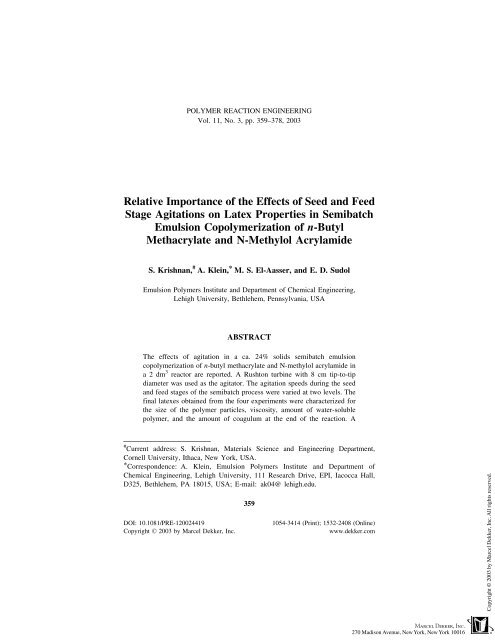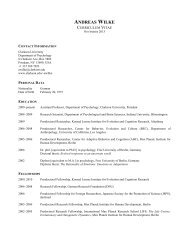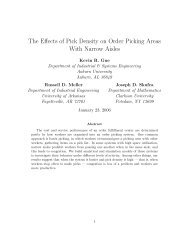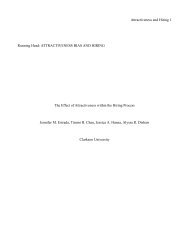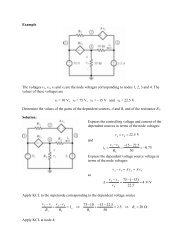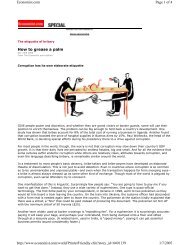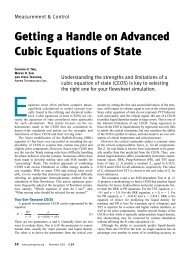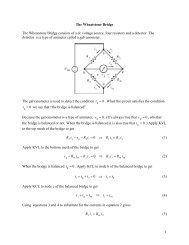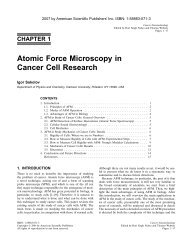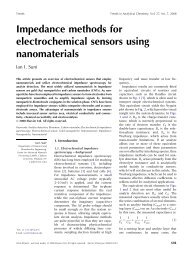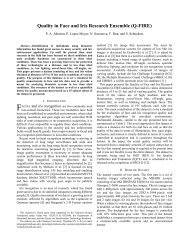Relative Importance of the Effects of Seed and Feed Stage ...
Relative Importance of the Effects of Seed and Feed Stage ...
Relative Importance of the Effects of Seed and Feed Stage ...
Create successful ePaper yourself
Turn your PDF publications into a flip-book with our unique Google optimized e-Paper software.
POLYMER REACTION ENGINEERING<br />
Vol. 11, No. 3, pp. 359–378, 2003<br />
<strong>Relative</strong> <strong>Importance</strong> <strong>of</strong> <strong>the</strong> <strong>Effects</strong> <strong>of</strong> <strong>Seed</strong> <strong>and</strong> <strong>Feed</strong><br />
<strong>Stage</strong> Agitations on Latex Properties in Semibatch<br />
Emulsion Copolymerization <strong>of</strong> n-Butyl<br />
Methacrylate <strong>and</strong> N-Methylol Acrylamide<br />
S. Krishnan, # A. Klein, * M. S. El-Aasser, <strong>and</strong> E. D. Sudol<br />
Emulsion Polymers Institute <strong>and</strong> Department <strong>of</strong> Chemical Engineering,<br />
Lehigh University, Bethlehem, Pennsylvania, USA<br />
ABSTRACT<br />
The effects <strong>of</strong> agitation in a ca. 24% solids semibatch emulsion<br />
copolymerization <strong>of</strong> n-butyl methacrylate <strong>and</strong> N-methylol acrylamide in<br />
a2dm 3 reactor are reported. A Rushton turbine with 8 cm tip-to-tip<br />
diameter was used as <strong>the</strong> agitator. The agitation speeds during <strong>the</strong> seed<br />
<strong>and</strong> feed stages <strong>of</strong> <strong>the</strong> semibatch process were varied at two levels. The<br />
final latexes obtained from <strong>the</strong> four experiments were characterized for<br />
<strong>the</strong> size <strong>of</strong> <strong>the</strong> polymer particles, viscosity, amount <strong>of</strong> water-soluble<br />
polymer, <strong>and</strong> <strong>the</strong> amount <strong>of</strong> coagulum at <strong>the</strong> end <strong>of</strong> <strong>the</strong> reaction. A<br />
# Current address: S. Krishnan, Materials Science <strong>and</strong> Engineering Department,<br />
Cornell University, Ithaca, New York, USA.<br />
*Correspondence: A. Klein, Emulsion Polymers Institute <strong>and</strong> Department <strong>of</strong><br />
Chemical Engineering, Lehigh University, 111 Research Drive, EPI, Iacocca Hall,<br />
D325, Bethlehem, PA 18015, USA; E-mail: ak04@ lehigh.edu.<br />
359<br />
DOI: 10.1081/PRE-120024419<br />
Copyright D 2003 by Marcel Dekker, Inc.<br />
1054-3414 (Print); 1532-2408 (Online)<br />
www.dekker.com
360 Krishnan et al.<br />
higher agitation speed nucleated a greater number <strong>of</strong> polymer particles<br />
during <strong>the</strong> in situ seed formation step (seed stage). In <strong>the</strong> absence <strong>of</strong> any<br />
secondary nucleation during <strong>the</strong> monomer-feeding stage, <strong>the</strong> final latexes<br />
had a higher number <strong>of</strong> particles when <strong>the</strong> agitation speed during <strong>the</strong><br />
seed stage was higher. The amount <strong>of</strong> coagulum increased with an<br />
increase in <strong>the</strong> agitation power-input. The amount <strong>of</strong> water-soluble<br />
polymer was influenced mainly by <strong>the</strong> agitation during <strong>the</strong> seed stage <strong>of</strong><br />
<strong>the</strong> process, through <strong>the</strong> effect <strong>of</strong> <strong>the</strong> latter on <strong>the</strong> number <strong>of</strong> polymer<br />
particles. However, <strong>the</strong> pooling <strong>of</strong> <strong>the</strong> BMA monomer during <strong>the</strong> feed<br />
stage, because <strong>of</strong> poor mixing <strong>and</strong> shear in <strong>the</strong> reactor, resulted in an<br />
increased water-soluble polymer formation. Latexes prepared using a<br />
higher agitation speed during <strong>the</strong> seed stage had a higher viscosity.<br />
Key Words: Agitation; <strong>Seed</strong>ed emulsion polymerization; Semi-batch<br />
emulsion polymerization.<br />
INTRODUCTION<br />
The objective <strong>of</strong> this work is to investigate <strong>the</strong> effects <strong>of</strong> seed stage <strong>and</strong><br />
feed stage agitation in a semibatch emulsion copolymerization <strong>of</strong> n-butyl<br />
methacrylate <strong>and</strong> N-methylol acrylamide. As seen in <strong>the</strong> previous paper<br />
(Krishnan et al., 2003), agitation affects <strong>the</strong> amount <strong>of</strong> water-soluble<br />
polymer in <strong>the</strong> final latex. Experiments using psuedoplastic latexes with<br />
relatively high solids content showed that <strong>the</strong> incorporation <strong>of</strong> <strong>the</strong> NMA<br />
monomer in <strong>the</strong> polymer particles increased with an increase in <strong>the</strong><br />
agitation power. This could be attributed to <strong>the</strong> combined effect <strong>of</strong> two<br />
factors: first, <strong>the</strong> effect <strong>of</strong> agitation (bulk mixing <strong>and</strong> shear rate) during <strong>the</strong><br />
feed stage, <strong>and</strong> second, <strong>the</strong> effect <strong>of</strong> agitation on particle nucleation during<br />
<strong>the</strong> seed stage. When <strong>the</strong> latex viscosity was high, mixing showed an effect<br />
on <strong>the</strong> water-soluble polymer formation even using a 2 dm 3 scale reactor.<br />
In this paper, we describe <strong>the</strong> effects <strong>of</strong> agitation on <strong>the</strong> properties <strong>of</strong> a<br />
24% solids latex with a lower viscosity <strong>and</strong> a Newtonian viscosity behavior.<br />
The relative effects <strong>of</strong> seed stage <strong>and</strong> feed stage agitations were determined<br />
using a simple 22 factorial design <strong>of</strong> experiments (Neuman, 1997).<br />
MATERIALS<br />
n-Butyl methacrylate inhibited by 10 ppm monomethyl e<strong>the</strong>r <strong>of</strong><br />
hydroquinone (MEHQ), N-methylol acrylamide (48 wt% solution in water)<br />
inhibited with 30 ppm <strong>of</strong> MEHQ, <strong>and</strong> potassium persulfate (ACS reagent)<br />
were obtained from Sigma-Aldrich. Sodium lauryl sulfate (Ultrapure
<strong>Seed</strong> <strong>and</strong> <strong>Feed</strong> <strong>Stage</strong> Agitations <strong>of</strong> BMA <strong>and</strong> NMA 361<br />
Bioreagent) was obtained from J. T. Baker, <strong>and</strong> sodium bicarbonate, from<br />
Mallinckrodt Baker. Nitrogen gas (Zero Grade 0.5, minimum purity<br />
99.998%, oxygen < 0.5 ppm) was obtained from Airgas. Deionized water<br />
was used for preparing <strong>the</strong> emulsions. The BMA monomer was passed<br />
through an inhibitor-removal column (Sigma-Aldrich) before use, <strong>and</strong> all<br />
<strong>the</strong> o<strong>the</strong>r chemicals were used as received.<br />
PROCEDURES<br />
Latex Syn<strong>the</strong>sis<br />
The details <strong>of</strong> <strong>the</strong> reactor <strong>and</strong> <strong>the</strong> experimental setup were given in <strong>the</strong><br />
previous paper (Krishnan et al., 2003). A monomer-starved semibatch<br />
process with in situ seed formation was developed for a ‘‘low-solids’’<br />
copolymer latex <strong>of</strong> BMA <strong>and</strong> NMA. The recipe is given in Table 1.<br />
The initial reactor charge consisted <strong>of</strong> BMA, <strong>and</strong> a solution <strong>of</strong> SDS<br />
<strong>and</strong> NaHCO 3 in ca. 930 g <strong>of</strong> DI water. The emulsion was heated to 70°C (in<br />
ca. 15 min) under <strong>the</strong> seed stage agitation speed. Nitrogen was bubbled<br />
through <strong>the</strong> emulsion during <strong>the</strong> heating <strong>and</strong> emulsification steps, which<br />
lasted for ca. 30 min. 20 g <strong>of</strong> <strong>the</strong> initiator solution (<strong>the</strong> recipe amount <strong>of</strong> KPS<br />
in DI water) was injected near <strong>the</strong> agitator using a stainless steel needle.<br />
Nitrogen was bubbled into <strong>the</strong> emulsion throughout <strong>the</strong> seed stage, <strong>and</strong> <strong>the</strong><br />
nitrogen tube was raised above <strong>the</strong> liquid level in <strong>the</strong> reactor during <strong>the</strong> feed<br />
stage. The seed stage <strong>and</strong> feed stage durations were 30 min <strong>and</strong> 90 min,<br />
respectively. A 30 min post-feeding time was allowed, after which, ca. 1 mL<br />
<strong>of</strong> 1% aqueous hydroquinone solution was injected into <strong>the</strong> reactor. The 8 cm<br />
diameter agitator was used in all <strong>the</strong> experiments. The agitation during <strong>the</strong><br />
Table 1.<br />
Recipe for emulsion copolymerization <strong>of</strong> BMA <strong>and</strong> NMA.<br />
<strong>Seed</strong> stage (70°C, 30 min)<br />
<strong>Feed</strong> stage (70°C, 90 min) b<br />
Ingredient Amount (g) Ingredient Amount (g)<br />
DI water 950.00 DI water 26.0<br />
BMA 50.00 BMA 241.4 (450 cm 3 )<br />
SLS 1.104 (4 mM) a NMA 24.0<br />
KPS<br />
0.769 (3 mM) a<br />
NaHCO 3<br />
0.736 (9.2 mM) a<br />
a Concentration in mmol per dm 3 water.<br />
b Final amount <strong>of</strong> polymer is ca. 24.4 wt% <strong>of</strong> latex.
362 Krishnan et al.<br />
Table 2. 22 Factorial design <strong>of</strong> experiments to study <strong>the</strong> effects <strong>of</strong> seed stage <strong>and</strong> feed stage rotational speeds.<br />
Expt.<br />
<strong>Seed</strong> stage<br />
rpm*<br />
<strong>Feed</strong> stage<br />
rpm*<br />
Coagulum<br />
(pphm)<br />
Dv<br />
(nm)<br />
Water-soluble<br />
species in final<br />
latex (g)<br />
Viscosity**<br />
(cP)<br />
1 150 ( 1) 150 ( 1) 0.0248 194.2 17.48 6.88<br />
2 400 (+1) 150 ( 1) 0.0337 168.7 17.96 7.24<br />
3 150 ( 1) 400 (+1) 0.1095 197.6 16.66 6.91<br />
4 400 (+1) 400 (+1) 0.1662 170.7 16.36 7.20<br />
*The numbers in <strong>the</strong> paren<strong>the</strong>ses are <strong>the</strong> encoded levels.<br />
**At a shear-rate <strong>of</strong> 461 s 1 .
<strong>Seed</strong> <strong>and</strong> <strong>Feed</strong> <strong>Stage</strong> Agitations <strong>of</strong> BMA <strong>and</strong> NMA 363<br />
seed stages <strong>and</strong> feed stages (‘‘factor’’) was varied by varying <strong>the</strong> speed <strong>of</strong> <strong>the</strong><br />
agitator at two levels. When <strong>the</strong> values <strong>of</strong> x factors are varied at n levels, a<br />
total <strong>of</strong> n x different experiments can be performed. Thus, <strong>the</strong> latexes were<br />
prepared using all <strong>the</strong> 2 2 possible permutations <strong>of</strong> agitation speeds. No<br />
monomer pooling was observed at any stage <strong>of</strong> <strong>the</strong> reaction, when <strong>the</strong> 8 cm<br />
Rushton turbine was used. After <strong>the</strong>ir syn<strong>the</strong>sis, <strong>the</strong> latexes were characterized<br />
for <strong>the</strong> ‘‘responses’’, viz., <strong>the</strong> amount <strong>of</strong> coagulum, <strong>the</strong> particle<br />
diameter, <strong>the</strong> amount <strong>of</strong> water-soluble polymer, <strong>and</strong> <strong>the</strong> viscosity. The agitation<br />
conditions <strong>and</strong> <strong>the</strong> results are shown in Table 2.<br />
Determination <strong>of</strong> Coagulum Amount<br />
For <strong>the</strong> determination <strong>of</strong> <strong>the</strong> amount <strong>of</strong> coagulum (aggregated polymer<br />
particles), <strong>the</strong> polymer on <strong>the</strong> reactor inserts were carefully scraped,<br />
collected, washed using a sieve with 53 mm pore size, dried in an oven at<br />
75°C, <strong>and</strong> weighed. The latex was also filtered through <strong>the</strong> sieve, but <strong>the</strong><br />
amount <strong>of</strong> coagulum in <strong>the</strong> latex was negligible.<br />
Characterization <strong>of</strong> Serum-Polymer<br />
Ultracentrifugation (Beckman, L8-55M ultracentrifuge) was used to<br />
separate <strong>the</strong> aqueous phase <strong>of</strong> <strong>the</strong> latex, commonly called <strong>the</strong> serum,<br />
from <strong>the</strong> polymer particles. It was found that ultracentrifugation <strong>of</strong> <strong>the</strong><br />
latex diluted with an equal mass <strong>of</strong> water resulted in a good separation<br />
<strong>of</strong> <strong>the</strong> serum <strong>and</strong> <strong>the</strong> particles. Centrifugation was carried out at<br />
37000 rpm <strong>and</strong> 4°C, for 6 h. Let x be <strong>the</strong> mass <strong>of</strong> a sample <strong>of</strong> <strong>the</strong><br />
original latex, w, <strong>the</strong> mass <strong>of</strong> water used for dilution, <strong>and</strong> y, <strong>the</strong> mass<br />
fraction <strong>of</strong> solids in <strong>the</strong> aqueous phase <strong>of</strong> <strong>the</strong> diluted latex. The mass<br />
fraction <strong>of</strong> solids in <strong>the</strong> serum <strong>of</strong> <strong>the</strong> original latex, f ws , was calculated<br />
using Eq. 1:<br />
f ws ¼<br />
<br />
y<br />
1 y<br />
<br />
f w þ w <br />
x<br />
ð1Þ<br />
where f w is <strong>the</strong> mass fraction <strong>of</strong> water in <strong>the</strong> original latex. If f a is<br />
<strong>the</strong> mass-fraction <strong>of</strong> non-polymeric solids in <strong>the</strong> serum (SDS, NaHCO 3 ,<br />
KPS, <strong>and</strong> unreacted NMA), <strong>the</strong> mass <strong>of</strong> water-soluble polymer in <strong>the</strong><br />
serum, M wsp (based on <strong>the</strong> total mass, M tot , <strong>of</strong> <strong>the</strong> recipe) is given by:<br />
M wsp ¼ M tot ðf ws f a Þ ð2Þ
364 Krishnan et al.<br />
Figure 1.<br />
1 H-NMR spectrum <strong>of</strong> water-soluble species in <strong>the</strong> latex.<br />
1 H-NMR spectra <strong>of</strong> <strong>the</strong> solids in <strong>the</strong> serum showed that <strong>the</strong>re are<br />
negligible amounts <strong>of</strong> SDS <strong>and</strong> unreacted NMA in <strong>the</strong> serum <strong>of</strong> <strong>the</strong> final<br />
latex. Figure 1 shows <strong>the</strong> spectrum for <strong>the</strong> water-soluble species in <strong>the</strong><br />
serum <strong>of</strong> <strong>the</strong> latex obtained from Run 4 (cf. Table 2). The serum was<br />
separated from <strong>the</strong> latex by ultracentrifugation. H 2 O was evaporated (at<br />
room temperature) from <strong>the</strong> serum by bubbling nitrogen into a glass vial<br />
containing <strong>the</strong> serum. The solids remaining in <strong>the</strong> vial were <strong>the</strong>n<br />
redissolved in D 2 O. On comparison <strong>of</strong> this spectrum with that reported in<br />
<strong>the</strong> previous paper (Krishnan et al., 2003), it is observed that <strong>the</strong> peaks<br />
corresponding to SDS are less pronounced in <strong>the</strong> former. This is expected<br />
because <strong>of</strong> <strong>the</strong> lower concentration <strong>of</strong> SDS in <strong>the</strong> latexes prepared using<br />
<strong>the</strong> recipe in Table 1, than that in <strong>the</strong> latexes <strong>of</strong> <strong>the</strong> previous paper<br />
(Krishnan et al., 2003).<br />
For <strong>the</strong> comparison <strong>of</strong> <strong>the</strong> effect <strong>of</strong> agitation on water-soluble polymer<br />
formation, we use <strong>the</strong> values <strong>of</strong> <strong>the</strong> total amount <strong>of</strong> water-soluble species,<br />
M ws obtained using Eq. 3. All o<strong>the</strong>r species in <strong>the</strong> serum (SDS, KPS,<br />
NaHCO 3 , any unreacted NMA) are expected to be in <strong>the</strong> same amounts in<br />
<strong>the</strong> serum for <strong>the</strong> different latexes, since <strong>the</strong> dilution <strong>of</strong> <strong>the</strong> latexes (for<br />
ultracentrifugation) was <strong>the</strong> same. The dependence <strong>of</strong> <strong>the</strong> amount <strong>of</strong> SDS in<br />
<strong>the</strong> serum, on <strong>the</strong> total surface area <strong>of</strong> <strong>the</strong> particles in <strong>the</strong> latex, is not<br />
expected to alter <strong>the</strong> results significantly.<br />
M ws ¼ M tot f ws ð3Þ
<strong>Seed</strong> <strong>and</strong> <strong>Feed</strong> <strong>Stage</strong> Agitations <strong>of</strong> BMA <strong>and</strong> NMA 365<br />
Determination <strong>of</strong> Particle Size Distribution <strong>and</strong><br />
Viscosity <strong>of</strong> Latex<br />
The particle diameters were measured using capillary hydrodynamic<br />
fractionation (CHDF 1100, Matec Applied Sciences). The latex viscosities<br />
(at room temperature) were measured using a Bohlin rheometer, <strong>and</strong> <strong>the</strong><br />
cup <strong>and</strong> cylinder arrangement.<br />
Data Analysis<br />
The objective is to develop equations that relate <strong>the</strong> responses <strong>and</strong> <strong>the</strong><br />
factors. For first order effects, <strong>the</strong> equation is <strong>of</strong> <strong>the</strong> form:<br />
y ¼ h þ m s x s þ m f x f<br />
ð4Þ<br />
where y is <strong>the</strong> response, h is <strong>the</strong> numerical average <strong>of</strong> <strong>the</strong> four responses,<br />
m s is <strong>the</strong> first order effect <strong>of</strong> independent variable (factor) S, m f is <strong>the</strong> first<br />
order effect <strong>of</strong> independent variable F, x s <strong>and</strong> x f are encoded levels <strong>of</strong><br />
variables S <strong>and</strong> F, respectively. S is <strong>the</strong> rotational speed <strong>of</strong> <strong>the</strong> agitator in<br />
<strong>the</strong> seed stage, <strong>and</strong> F is <strong>the</strong> speed during <strong>the</strong> feed stage. To simplify <strong>the</strong><br />
analysis, <strong>the</strong> independent variable levels are encoded as follows:<br />
High level = +1<br />
Low level = 1<br />
Thus, an agitator speed <strong>of</strong> 200 rpm corresponds to <strong>the</strong> encoded level <strong>of</strong><br />
(200–275)/(275–150) = 0.6 <strong>and</strong> an agitator speed <strong>of</strong> 300 rpm corresponds<br />
to <strong>the</strong> encoded level <strong>of</strong> (300–275)/(400–275) = 0.2, where 275 rpm is <strong>the</strong><br />
mid level. The encoded levels <strong>of</strong> agitation speeds are enclosed in <strong>the</strong><br />
brackets in Table 2.<br />
If y 1 , y 2 , y 3 , <strong>and</strong> y 4 are <strong>the</strong> outputs (responses) <strong>of</strong> <strong>the</strong> variable y from<br />
<strong>the</strong> four runs, <strong>the</strong> first order effects can be calculated using Eqs. 5–7.<br />
S LO ¼ y 1 þ y 3<br />
2<br />
S HI ¼ y 2 þ y 4<br />
2<br />
m s ¼ S HI S LO<br />
2<br />
ð5Þ
366 Krishnan et al.<br />
F LO ¼ y 1 þ y 2<br />
2<br />
F HI ¼ y 3 þ y 4<br />
2<br />
m f ¼ F HI F LO<br />
2<br />
h ¼ y 1 þ y 2 þ y 3 þ y 4<br />
4<br />
The experimental error is calculated as follows:<br />
E LO ¼ y 2 þ y 3<br />
2<br />
E HI ¼ y 1 þ y 4<br />
2<br />
m e ¼ E HI E LO<br />
2<br />
error ¼ absðm e Þ<br />
ð6Þ<br />
ð7Þ<br />
ð8Þ<br />
The calculation <strong>of</strong> <strong>the</strong> first order effect involves all four experimental<br />
data. The averaging reduces <strong>the</strong> influence <strong>of</strong> an error in any datum. The<br />
coefficients m s <strong>and</strong> m f can be directly compared to determine <strong>the</strong> relative<br />
importance <strong>of</strong> each independent variable. For a measured effect to be<br />
significant, it has to be greater than <strong>the</strong> experimental error. The error also<br />
includes <strong>the</strong> deviation <strong>of</strong> <strong>the</strong> experimental effect from <strong>the</strong> simple model<br />
assumed (Eq. 4).<br />
RESULTS<br />
Effect <strong>of</strong> Agitation on Coagulum Formation<br />
Shear-induced coagulation in latexes has been studied by several<br />
researchers (Ali <strong>and</strong> Zollars, 1987, 1988; Husb<strong>and</strong> <strong>and</strong> Adams, 1992;<br />
Kusters et al., 1997; Lowry et al., 1984, 1986; Matejicek et al., 1988;<br />
Utracki, 1973; Zollars <strong>and</strong> Ali, 1986). Smoluchowski’s expression for<br />
orthokinetic (shear-induced) flocculation is normally used to describe <strong>the</strong><br />
rate <strong>of</strong> shear-induced aggregation. The collision frequency in <strong>the</strong> absence <strong>of</strong><br />
interparticle forces, for uniform particles approaching each o<strong>the</strong>r along<br />
rectilinear paths, was predicted by Smoluchowski to be (16/3)N 2 p a3 g where<br />
N p is <strong>the</strong> number <strong>of</strong> particles per unit volume, a is <strong>the</strong> particle radius, <strong>and</strong> g<br />
is <strong>the</strong> shear rate (von Smoluchowski, 1917). If each collision results in
<strong>Seed</strong> <strong>and</strong> <strong>Feed</strong> <strong>Stage</strong> Agitations <strong>of</strong> BMA <strong>and</strong> NMA 367<br />
aggregation, this also gives <strong>the</strong> rate <strong>of</strong> shear-induced aggregation. However,<br />
<strong>the</strong> surfactant molecules on <strong>the</strong> surface <strong>of</strong> <strong>the</strong> latex particles provide<br />
stability to <strong>the</strong> particles, by electrostatic or steric repulsion, <strong>and</strong> only those<br />
collisions with force sufficient to overcome <strong>the</strong> repulsive force barrier will<br />
be effective. Husb<strong>and</strong> <strong>and</strong> Adams (1992) have studied <strong>the</strong> orthokinetic<br />
flocculation <strong>of</strong> carboxylated latex particles <strong>and</strong> have found that a certain<br />
minimum shear rate was required to initiate aggregation. The minimum<br />
shear rate could be predicted by equating <strong>the</strong> electrostatic repulsive force<br />
between a pair <strong>of</strong> particles <strong>and</strong> <strong>the</strong> hydrodynamic shear force opposing it.<br />
Thus, in <strong>the</strong> presence <strong>of</strong> repulsive interparticle forces, <strong>the</strong> rate <strong>of</strong> decrease<br />
in <strong>the</strong> number concentration <strong>of</strong> particles is given by:<br />
dN p<br />
dt<br />
¼<br />
16 3 N2 p a3 g<br />
W<br />
where W is a stability factor. When <strong>the</strong> colliding particles coalesce <strong>and</strong><br />
form spherical aggregates, Eq. 10 can be expressed in a pseudo-first order<br />
form (Koh et al., 1984):<br />
dN p<br />
dt<br />
¼<br />
4f gN p<br />
pW<br />
ð9Þ<br />
ð10Þ<br />
where f=4pa 3 N p /3 is <strong>the</strong> particle volume fraction, which remains constant<br />
during a batch flocculation process. Integration <strong>of</strong> Eq. 10 with respect to<br />
time gives<br />
<br />
ln<br />
N p<br />
N p;0<br />
<br />
¼<br />
4f g<br />
pW t<br />
ð11Þ<br />
where N p,0 is <strong>the</strong> number <strong>of</strong> particles at t =0. If c is <strong>the</strong> fraction <strong>of</strong> particles<br />
coagulated at time t, <strong>the</strong>n<br />
or,<br />
lnð1 cÞ ¼ 4f g<br />
pW t<br />
ð12Þ<br />
c 4f g<br />
pW t<br />
ð13Þ<br />
for c less than ca. 10%. Thus, <strong>the</strong> amount <strong>of</strong> coagulum is expected to be<br />
proportional to f, <strong>the</strong> volume fraction <strong>of</strong> <strong>the</strong> particles in <strong>the</strong> suspension, g,<br />
<br />
<strong>the</strong> shear rate, <strong>the</strong> time t for which <strong>the</strong> latex is sheared, <strong>and</strong> inversely<br />
proportional to <strong>the</strong> stability factor, W.<br />
Based on <strong>the</strong> assumptions <strong>of</strong> homogeneous isotropic turbulent flow in<br />
a stirred vessel, a frequent assumption is that <strong>the</strong> average shear rate, g<br />
<br />
avg ,
368 Krishnan et al.<br />
is proportional to <strong>the</strong> square root <strong>of</strong> <strong>the</strong> power input per unit volume (Koh<br />
et al., 1984; Kusters et al., 1997; Lowry et al., 1984, 1986):<br />
<br />
g avg ¼<br />
<br />
2P 0:5<br />
ð14Þ<br />
15mV R<br />
where P is <strong>the</strong> power-input, V R is <strong>the</strong> volume <strong>of</strong> <strong>the</strong> liquid in <strong>the</strong> reactor,<br />
<strong>and</strong> m, <strong>the</strong> viscosity <strong>of</strong> <strong>the</strong> fluid. For a 40, 45, <strong>and</strong> 50% solids batch<br />
emulsion copolymerizations <strong>of</strong> vinyl chloride <strong>and</strong> ethyl acrylate in a 2<br />
gallon reactor, Lowry et al. (1984, 1986) found that <strong>the</strong> amounts <strong>of</strong><br />
coagulum at <strong>the</strong> end <strong>of</strong> <strong>the</strong> polymerization could be correlated to <strong>the</strong><br />
agitation power-inputs using Eqs. 12 <strong>and</strong> 14. Similarly, for semibatch<br />
emulsion polymerization <strong>of</strong> BMA <strong>and</strong> its copolymerization with NMA,<br />
Dave (1998) found that <strong>the</strong> mass <strong>of</strong> coagulum was proportional to P 0.5 ,as<br />
expected from Eqs. 13 <strong>and</strong> 14.<br />
Some experimental results that do not conform to Eqs. 9 or 13 must<br />
also be pointed out. Eq. 13 indicates that amount <strong>of</strong> coagulum is directly<br />
proportional to <strong>the</strong> time to which <strong>the</strong> suspension is subjected to <strong>the</strong> shear<br />
rate g. However, using viscosity measurements, Utracki (1973) has found<br />
that <strong>the</strong> high rate macrocoagulation process was preceded by an induction<br />
period called <strong>the</strong> coagulation time, t c , during which <strong>the</strong> coagulation energy<br />
necessary to overcome <strong>the</strong> threshold energy <strong>of</strong> coagulation, accumulated in<br />
<strong>the</strong> system. Microcoagulation (formation <strong>of</strong> doublets <strong>and</strong> triplets) occurred<br />
during <strong>the</strong> induction period. Instead <strong>of</strong> <strong>the</strong> exponential decrease <strong>of</strong> <strong>the</strong><br />
particle number with time as suggested by Eq. 11, Utracki proposed that <strong>the</strong><br />
number <strong>of</strong> particles decreased linearly with time during <strong>the</strong> induction<br />
period. His <strong>the</strong>oretical equation relating t c to <strong>the</strong> shear rate, g, <strong>and</strong> volume<br />
fraction <strong>of</strong> dispersed phase, f, was confirmed by <strong>the</strong> experimental data for<br />
poly(vinyl chloride) <strong>and</strong> poly(vinyl acetate) latexes. Also, Zollars <strong>and</strong> Ali<br />
(1987) found that when <strong>the</strong> repulsive forces (arising from adsorbed<br />
surfactant, or chemically bound surface groups) between <strong>the</strong> latex particles<br />
were high, <strong>the</strong> shear coagulation rate decreased with an increase in <strong>the</strong><br />
particle volume fraction, f, in contrast to Eq. 10. This unusual result was<br />
attributed to <strong>the</strong> decrease in <strong>the</strong> collisional efficiency with increasing<br />
particle volume fraction. However, when <strong>the</strong> latex particles possessed only<br />
weak repulsive forces, <strong>the</strong> coagulation rate increased linearly with f, as<br />
expected. Their work involved very low particle volume fractions, ranging<br />
from 4.2910 5 to 6.8610 4 . Matejicek et al. (1988) have reported that<br />
during a 52% solids semibatch emulsion terpolymerization <strong>of</strong> styrene, n-<br />
butyl acrylate, <strong>and</strong> acrylic acid, in a 25 dm 3 stirred reactor, <strong>the</strong> amount <strong>of</strong><br />
coagulum decreased with an increase in P/V R below a specific power-input<br />
(P/V R ) <strong>of</strong> 80 W/m 3 . They attributed this coagulum formation to poor
<strong>Seed</strong> <strong>and</strong> <strong>Feed</strong> <strong>Stage</strong> Agitations <strong>of</strong> BMA <strong>and</strong> NMA 369<br />
homogenization <strong>of</strong> <strong>the</strong> emulsion in <strong>the</strong> reactor at <strong>the</strong> low power-input<br />
values. However, above 80 W/m 3 , <strong>the</strong> coagulum increased with an increase<br />
in P/V R . However, instead <strong>of</strong> <strong>the</strong> expected order <strong>of</strong> dependence <strong>of</strong> 0.5, <strong>the</strong>y<br />
found that <strong>the</strong> coagulum was proportional to (P/V R ) 1.25 . Chern et al. (1996)<br />
have studied <strong>the</strong> stability <strong>of</strong> methyl methacrylate (MMA) <strong>and</strong> n-butyl<br />
acrylate (BA) copolymer latexes, <strong>and</strong> have found that <strong>the</strong> amount <strong>of</strong><br />
coagulum increased with <strong>the</strong> agitation speed, but <strong>the</strong> effects <strong>of</strong> o<strong>the</strong>r<br />
variables like electrolyte concentration, amount <strong>of</strong> surfactant in <strong>the</strong><br />
monomer feed, relative amounts <strong>of</strong> MMA <strong>and</strong> BA, <strong>and</strong> solids content,<br />
were more significant.<br />
Eq. 15 relates <strong>the</strong> amount <strong>of</strong> coagulum to <strong>the</strong> agitation speed during <strong>the</strong><br />
seed stage (x s ) <strong>and</strong> <strong>the</strong> feed stage (x f ) <strong>of</strong> our experiments:<br />
% coagulum ¼ 0:0836 þ 0:0164x s þ 0:0543x f<br />
error ¼ 0:0120<br />
ð15Þ<br />
The positive values <strong>of</strong> m s <strong>and</strong> m f confirm <strong>the</strong> expected result that <strong>the</strong><br />
amount <strong>of</strong> coagulum increases with <strong>the</strong> agitation speed. It is seen from <strong>the</strong><br />
magnitudes <strong>of</strong> <strong>the</strong> coefficients <strong>of</strong> x s <strong>and</strong> x f that <strong>the</strong> feed stage agitation has a<br />
stronger effect on <strong>the</strong> coagulum than <strong>the</strong> seed stage agitation. This is<br />
expected for <strong>the</strong> following reasons: 1) <strong>the</strong> volume fraction <strong>of</strong> solids is lower<br />
during <strong>the</strong> seed stage; 2) <strong>the</strong> surface-coverage <strong>of</strong> <strong>the</strong> particles is higher<br />
during <strong>the</strong> seed stage, providing greater electrostatic repulsion between <strong>the</strong><br />
particles; 3) <strong>the</strong> surface coverage decreases during <strong>the</strong> feed stage as <strong>the</strong><br />
particles grow in surface area; 4) <strong>the</strong> larger particles <strong>of</strong> <strong>the</strong> feed stage will<br />
be more sensitive to shear-induced aggregation than <strong>the</strong> smaller particles <strong>of</strong><br />
<strong>the</strong> seed stage (Ottewill, 1997); <strong>and</strong> 5) <strong>the</strong> feed stage duration is longer (90<br />
min compared to <strong>the</strong> 30 min <strong>of</strong> seed stage).<br />
In all our experiments, it was observed that most <strong>of</strong> <strong>the</strong> coagulum was<br />
on <strong>the</strong> agitator blades, <strong>and</strong> <strong>the</strong> reactor inserts. The amount <strong>of</strong> coagulum in<br />
<strong>the</strong> latex was negligible. This suggests two possibilities. First, all <strong>the</strong><br />
coagulum is formed near <strong>the</strong> agitator. Second, <strong>the</strong> coagulum is formed in<br />
<strong>the</strong> bulk <strong>of</strong> <strong>the</strong> reactor, <strong>and</strong> <strong>the</strong> aggregates are captured by <strong>and</strong> adhere to <strong>the</strong><br />
agitator blades when <strong>the</strong>y pass through <strong>the</strong> agitator region in <strong>the</strong> reactor.<br />
The shear rate in a stirred reactor is not uniform throughout <strong>the</strong> reactor.<br />
It is higher in <strong>the</strong> region near <strong>the</strong> agitator. Van’t Riet <strong>and</strong> Smith (1975)<br />
showed that in a turbine stirred vessel, a trailing vortex pair existed behind<br />
each stirrer blade <strong>and</strong> that <strong>the</strong> trailing vortices are associated with<br />
centrifugal accelerations <strong>and</strong> high shear rates. They have found that <strong>the</strong><br />
trailing vortex system leaving <strong>the</strong> blade tips deviates greatly from isotropic<br />
conditions (Van’t Riet et al., 1976). As an example, a 5 cm diameter<br />
Rushton turbine stirring a Newtonian liquid with a viscosity <strong>of</strong> 1 cP <strong>and</strong> a
370 Krishnan et al.<br />
density <strong>of</strong> 1 g/cm 3 at 600 rpm (10 rotations/s) in a 15 cm diameter reactor,<br />
with a liquid height <strong>of</strong> 15 cm, can be considered. For a power number <strong>of</strong> 5,<br />
<strong>the</strong> power-input per unit volume can be calculated to be 5895 erg s 1<br />
cm 3 . Using Eq. 14, this corresponds to an average shear rate <strong>of</strong> 280 s 1 .<br />
The Reynolds number (Re) <strong>of</strong> <strong>the</strong> flow, given by ND 2 r/m, is 25,000. For Re<br />
between 15,000 <strong>and</strong> 90,000, Van’t Riet <strong>and</strong> Smith (1975) showed that <strong>the</strong><br />
shear rate in <strong>the</strong> region immediately behind <strong>the</strong> blade can reach values as<br />
high as 90 N. In <strong>the</strong> above example, this corresponds to a shear rate <strong>of</strong> 900<br />
s 1 . Thus, <strong>the</strong> trailing vortices behind <strong>the</strong> agitator blades can be <strong>the</strong> main<br />
loci for coagulum formation. The shear rate at a given point in <strong>the</strong> trailing<br />
vortex is a function <strong>of</strong> Re only. Hence, <strong>the</strong> scale-up criterion <strong>of</strong> constant Re<br />
seems more logical than constant (P/V R ). It is also important how<br />
frequently <strong>the</strong> fluid passes through <strong>the</strong> agitator region. The frequency <strong>of</strong><br />
fluid circulation in <strong>the</strong> reactor will be proportional to ND 3 . If <strong>the</strong> circulation<br />
rate is much higher than <strong>the</strong> coagulation rate, <strong>the</strong> maximum shear rate,<br />
which is in <strong>the</strong> agitator region, will control <strong>the</strong> coagulation process. During<br />
emulsion polymerization <strong>of</strong> BMA in a stirred reactor, we found that <strong>the</strong><br />
order <strong>of</strong> dependence <strong>of</strong> <strong>the</strong> amount <strong>of</strong> coagulum on <strong>the</strong> agitation speed was<br />
recipe dependent, <strong>and</strong> significantly different from 1.5 (Krishnan, 2002).<br />
However, because <strong>of</strong> <strong>the</strong> combined effect <strong>of</strong> <strong>the</strong> above-discussed factors,<br />
an order different from <strong>the</strong> value <strong>of</strong> 1.5 based on Eq. 14 (P/N 3 D 5 ) is<br />
not unexpected.<br />
Effect <strong>of</strong> Agitation on Particle Diameter<br />
Eq. 16 shows a strong dependence <strong>of</strong> <strong>the</strong> particle diameter in <strong>the</strong> final<br />
latex on <strong>the</strong> seed stage rpm.<br />
D v ðnmÞ ¼182:8<br />
error ¼ 0:35<br />
13:1x s þ 1:35x f<br />
ð16Þ<br />
The negative coefficient indicates that volume-average particle diameter in<br />
<strong>the</strong> final latex decreases as <strong>the</strong> seed stage rpm increases. Thus, more<br />
particles are nucleated under higher agitation speed, which is consistent<br />
with <strong>the</strong> results reported in <strong>the</strong> previous paper (Krishnan et al., 2003). The<br />
comparatively smaller coefficient for <strong>the</strong> feed stage rpm indicates that<br />
secondary particle nucleation or shear-induced aggregation were negligible<br />
during <strong>the</strong> feed stage. Figure 2 shows <strong>the</strong> particle size distributions in <strong>the</strong><br />
seed <strong>and</strong> final latexes corresponding to experiments 1 to 4 in Table 2. The<br />
distributions were obtained by capillary hydrodynamic fractionation. The<br />
particle diameters <strong>of</strong> <strong>the</strong> final latexes are given in Table 2. It is seen that
<strong>Seed</strong> <strong>and</strong> <strong>Feed</strong> <strong>Stage</strong> Agitations <strong>of</strong> BMA <strong>and</strong> NMA 371<br />
Figure 2.<br />
Table 2.<br />
Particle size distribution in seed <strong>and</strong> feed latexes for <strong>the</strong> experiments in<br />
<strong>the</strong> particle diameter in <strong>the</strong> seed was smaller when <strong>the</strong> agitation speed was<br />
higher. The figure shows a fairly good reproducibility <strong>of</strong> <strong>the</strong> particle size<br />
distributions. The final latexes show peaks at higher or lower particle<br />
diameters, corresponding to <strong>the</strong> particle sizes in <strong>the</strong> seed latexes. The<br />
diameter in <strong>the</strong> final latex is not affected by <strong>the</strong> feed stage agitation.<br />
The decrease in <strong>the</strong> particle diameter with an increase in <strong>the</strong> agitation<br />
is a recurring feature for particle nucleation in systems with surfactant<br />
concentrations near <strong>the</strong> critical micelle concentration. Arai et al. (1981)<br />
have observed an increase in <strong>the</strong> number <strong>of</strong> particles with <strong>the</strong> increase in<br />
<strong>the</strong> agitation speed during surfactant free emulsion polymerizations <strong>of</strong><br />
methyl methacrylate using KPS initiator at 65°C. Varela de la Rosa (1991)<br />
has reported <strong>the</strong> heat evolution rates during emulsion polymerizations <strong>of</strong><br />
styrene using KPS initiator at 70°C at an SDS concentration <strong>of</strong> 10 mmol<br />
dm 3 for agitator speeds <strong>of</strong> 300 rpm <strong>and</strong> 500 rpm. The particle diameter<br />
was smaller <strong>and</strong> <strong>the</strong> reaction rate higher, when <strong>the</strong> agitator speed was 500<br />
rpm. In <strong>the</strong> absence <strong>of</strong> any oxygen impurity in <strong>the</strong> reactor, this effect can<br />
be explained by <strong>the</strong> interfacial nucleation mechanism recently proposed by<br />
Ni et al. (2001). According to this mechanism, under <strong>the</strong> influence <strong>of</strong><br />
shear, minidroplets are formed at <strong>the</strong> interface <strong>of</strong> <strong>the</strong> monomer droplets<br />
<strong>and</strong> water. These minidroplets result in <strong>the</strong> nucleation <strong>of</strong> <strong>the</strong> polymer<br />
particles. The greater <strong>the</strong> agitation, <strong>the</strong> higher <strong>the</strong> number <strong>of</strong> <strong>the</strong>se minidroplets,<br />
<strong>and</strong> <strong>the</strong> resulting polymer particles. Trace amounts (ppm levels) <strong>of</strong><br />
oxygen impurity in <strong>the</strong> reactor headspace <strong>and</strong> <strong>the</strong> agitation dependent mass
372 Krishnan et al.<br />
transfer rate <strong>of</strong> oxygen from <strong>the</strong> headspace into <strong>the</strong> emulsion can also result<br />
in a higher number <strong>of</strong> polymer particles at a higher agitation speed<br />
(Krishnan, 2002).<br />
Effect <strong>of</strong> Agitation on NMA Incorporation<br />
Eq. 17 correlates <strong>the</strong> effect <strong>of</strong> agitation speed on <strong>the</strong> amount <strong>of</strong> watersoluble<br />
species in <strong>the</strong> latex serum.<br />
water-soluble species ðgÞ ¼ 17:115<br />
error ¼ 0:195<br />
0:605x s þ 0:045x f<br />
ð17Þ<br />
The negative coefficient for <strong>the</strong> seed stage agitation speed implies that <strong>the</strong><br />
amount <strong>of</strong> water-soluble species decreases with an increase in <strong>the</strong> seed<br />
stage agitation speed. The effect <strong>of</strong> feed stage agitation is negligible, <strong>and</strong> is<br />
below <strong>the</strong> limits <strong>of</strong> experimental error. This may seem surprising, because<br />
<strong>the</strong> copolymerization reaction occurs only during <strong>the</strong> feed stage, <strong>and</strong> a<br />
greater influence <strong>of</strong> <strong>the</strong> feed stage agitation on <strong>the</strong> amount <strong>of</strong> water-soluble<br />
polymer would be expected. This can be explained on <strong>the</strong> basis <strong>of</strong> <strong>the</strong><br />
higher number <strong>of</strong> particles nucleated at higher agitation speed during <strong>the</strong><br />
seed stage. The copolymerization <strong>of</strong> NMA in <strong>the</strong> polymer particles has to<br />
compete with <strong>the</strong> aqueous phase polymerization <strong>of</strong> NMA. Because <strong>of</strong> <strong>the</strong><br />
hydrophilicity <strong>of</strong> <strong>the</strong> NMA monomer, <strong>the</strong> polymer formed in <strong>the</strong> aqueous<br />
phase will remain water-soluble as long as it contains a significant number<br />
<strong>of</strong> NMA units. If <strong>the</strong> number <strong>of</strong> polymer particles is higher, <strong>the</strong> extent <strong>of</strong><br />
copolymerization <strong>of</strong> NMA at <strong>the</strong> particle loci (within <strong>the</strong> particles or at <strong>the</strong><br />
surface <strong>of</strong> <strong>the</strong> particles) will be higher. This would result in a lower amount<br />
<strong>of</strong> water-soluble polymer. The 1 H-NMR spectra <strong>of</strong> <strong>the</strong> solids in <strong>the</strong> serum<br />
show that <strong>the</strong> proportion <strong>of</strong> <strong>the</strong> BMA units to <strong>the</strong> NMA units in <strong>the</strong> serum<br />
polymer is very small, that is, <strong>the</strong> serum polymer is mainly homopolymer<br />
<strong>of</strong> NMA.<br />
The latexes prepared using <strong>the</strong> recipe in Table 1 had lower viscosities<br />
than <strong>the</strong> high-solids latexes reported previously (Krishnan et al., 2003). The<br />
viscosities, especially at <strong>the</strong> lower shear rates, were at least 2 orders <strong>of</strong><br />
magnitude lower. The plots <strong>of</strong> viscosity vs. shear rate are relatively flat in<br />
contrast to <strong>the</strong> strong shear-thinning behavior <strong>of</strong> <strong>the</strong> high-solids latexes.<br />
Also, <strong>the</strong> 8 cm diameter agitator was used in <strong>the</strong> low-solids emulsion<br />
copolymerization experiments. This agitator could maintain good top-tobottom<br />
uniformity in <strong>the</strong> reactor, even at 150 rpm. These factors resulted in<br />
<strong>the</strong> non-dependence <strong>of</strong> <strong>the</strong> amount <strong>of</strong> water-soluble polymer on <strong>the</strong> feed<br />
stage agitation.
<strong>Seed</strong> <strong>and</strong> <strong>Feed</strong> <strong>Stage</strong> Agitations <strong>of</strong> BMA <strong>and</strong> NMA 373<br />
Figure 3. Effect <strong>of</strong> agitation speeds on <strong>the</strong> viscosities <strong>of</strong> <strong>the</strong> final latexes. The pairs<br />
<strong>of</strong> numbers in <strong>the</strong> figure are <strong>the</strong> seed stage <strong>and</strong> feed stage agitation speeds,<br />
respectively. The solid curves show <strong>the</strong> viscosity values as <strong>the</strong> shear rate was<br />
increased, <strong>and</strong> <strong>the</strong> dashed curves correspond to <strong>the</strong> decreasing shear rates.<br />
Effect <strong>of</strong> Agitation on Latex Viscosity<br />
Figure 3 compares <strong>the</strong> viscosities <strong>of</strong> <strong>the</strong> latexes prepared under<br />
different agitation conditions. Eq. 18 shows <strong>the</strong> viscosity <strong>of</strong> <strong>the</strong> final latex<br />
(at a shear rate <strong>of</strong> 461 s 1 ) as a function <strong>of</strong> <strong>the</strong> seed stage <strong>and</strong> feed stage<br />
agitator speeds.<br />
Latex viscosity ðcPÞ ¼ 7:058 þ 0:163x s<br />
error ¼ 0:018<br />
0:003x f<br />
ð18Þ<br />
On comparing <strong>the</strong> coefficients <strong>of</strong> x s <strong>and</strong> x f , it is clear that <strong>the</strong> agitator speed<br />
during <strong>the</strong> seed stage has a greater influence on <strong>the</strong> viscosity <strong>of</strong> <strong>the</strong> final<br />
latex, compared to <strong>the</strong> rotational speed during <strong>the</strong> feed stage. The increase<br />
in viscosity with an increase in <strong>the</strong> seed stage agitation is attributed to <strong>the</strong><br />
higher number <strong>of</strong> particles in <strong>the</strong> final latexes, as discussed in <strong>the</strong> previous<br />
paper (Krishnan et al., 2003).<br />
Molecular Weight <strong>of</strong> <strong>the</strong> Serum-Polymer<br />
The molecular weight distribution <strong>of</strong> <strong>the</strong> serum-phase polymer was<br />
determined using gel permeation chromatography (GPC, Waters 515 HPLC
374 Krishnan et al.<br />
Figure 4. The GPC detector response as a function <strong>of</strong> elution time, for <strong>the</strong> polymer<br />
in <strong>the</strong> aqueous phase <strong>of</strong> <strong>the</strong> latexes. The area under <strong>the</strong> curve is proportional to <strong>the</strong><br />
total amount <strong>of</strong> water-soluble polymer in <strong>the</strong> injected sample.<br />
Pump, Tosoh Biosep TSK-GEL columns GMPWXL <strong>and</strong> PWXL, <strong>and</strong><br />
Waters 410 Differential Refractometer detector). Figure 4 shows <strong>the</strong><br />
response <strong>of</strong> a refractive index detector as a function <strong>of</strong> <strong>the</strong> elution time. A<br />
0.01 M NaNO 3 solution was used as <strong>the</strong> eluant. The final latexes were<br />
diluted with equal masses <strong>of</strong> water (to a solids content <strong>of</strong> ca. 12.2 wt%).<br />
The diluted latexes were ultracentrifuged at 37000 rpm <strong>and</strong> 4°C for 5 h.<br />
The solids content in <strong>the</strong> serum was ca. 0.7 wt%. The serum was directly<br />
injected into <strong>the</strong> GPC column. The area under <strong>the</strong> response curve is<br />
proportional to <strong>the</strong> total amount <strong>of</strong> water-soluble polymer present in <strong>the</strong><br />
serum. The data in Figure 4 are consistent with <strong>the</strong> gravimetric results<br />
shown in Table 2. The amount <strong>of</strong> water-soluble polymer is higher when <strong>the</strong><br />
seed stage agitation speed is lower.<br />
Monomer Emulsification<br />
In <strong>the</strong> experiments reported in Table 2, <strong>the</strong>re was no pooling <strong>of</strong> <strong>the</strong><br />
BMA monomer at any point <strong>of</strong> <strong>the</strong> reaction. However, when a Rushton<br />
turbine with 4 cm diameter was used at 400 rpm (both seed <strong>and</strong> feed
<strong>Seed</strong> <strong>and</strong> <strong>Feed</strong> <strong>Stage</strong> Agitations <strong>of</strong> BMA <strong>and</strong> NMA 375<br />
Figure 5.<br />
conditions.<br />
The amount <strong>of</strong> water-soluble species in <strong>the</strong> latexes for different agitation<br />
stages), <strong>the</strong> BMA monomer started to form a pool at ca. 60 min <strong>of</strong> <strong>the</strong> feed<br />
stage, <strong>and</strong> by ca. 80 min, a ca. 0.5 cm monomer layer accumulated at <strong>the</strong><br />
top <strong>of</strong> <strong>the</strong> reactor. The solids content in <strong>the</strong> final latex was ca. 23 wt%.<br />
Figure 5 compares <strong>the</strong> amount <strong>of</strong> water-soluble species in <strong>the</strong> serum formed<br />
when <strong>the</strong> 4 cm agitator was used, with those in <strong>the</strong> latexes prepared using<br />
<strong>the</strong> 8 cm agitator. Clearly, <strong>the</strong> amount <strong>of</strong> water-soluble solids is higher.<br />
Thus, a poor emulsification <strong>of</strong> <strong>the</strong> BMA monomer results in a slower rate<br />
<strong>of</strong> transfer <strong>of</strong> <strong>the</strong> BMA monomer to <strong>the</strong> polymer particles. The proportion<br />
<strong>of</strong> <strong>the</strong> added NMA monomer that homopolymerizes, is greater compared to<br />
<strong>the</strong> amount copolymerizing with BMA. Thus, a greater amount <strong>of</strong> watersoluble<br />
polymer is formed.<br />
The frequency at which <strong>the</strong> fluid recirculates through <strong>the</strong> agitator<br />
region is proportional to ND 3 . Thus, <strong>the</strong> fluid passed through <strong>the</strong> agitator<br />
region less frequently with <strong>the</strong> 4 cm agitator than with <strong>the</strong> 8 cm agitator.<br />
Emulsification <strong>of</strong> <strong>the</strong> added BMA occurs in <strong>the</strong> high-shear agitator region.<br />
The size <strong>of</strong> <strong>the</strong> BMA droplets will be lower with a higher shear rate in <strong>the</strong><br />
agitator region, <strong>and</strong> more frequent recirculation through this region. Thus,<br />
<strong>the</strong> BMA droplets produced by <strong>the</strong> 4 cm agitator will be larger compared<br />
to those produced by <strong>the</strong> 8 cm agitator. The surfactant coverage <strong>of</strong> <strong>the</strong><br />
polymer particles <strong>and</strong> <strong>the</strong> monomer droplets decreases during <strong>the</strong> feed stage<br />
because <strong>of</strong> growing surface area (<strong>and</strong> no added surfactant). The monomer<br />
droplets rise to <strong>the</strong> surface <strong>of</strong> <strong>the</strong> reactor <strong>and</strong> coalesce to form a pool.
376 Krishnan et al.<br />
CONCLUSIONS<br />
Agitation has a strong effect on <strong>the</strong> properties <strong>of</strong> <strong>the</strong> latex prepared by<br />
emulsion polymerization. More particles are nucleated under a higher<br />
agitation speed. This observation is consistent with <strong>the</strong> mechanism <strong>of</strong><br />
interfacial particle nucleation (Varela de la Rosa, 1991), wherein <strong>the</strong> shear<br />
stress generated by <strong>the</strong> agitation results in <strong>the</strong> formation <strong>of</strong> minidroplets<br />
near <strong>the</strong> surface <strong>of</strong> <strong>the</strong> monomer droplets, <strong>and</strong> polymer particles are formed<br />
by <strong>the</strong> nucleation <strong>of</strong> <strong>the</strong>se minidroplets. Although <strong>the</strong> reactions were carried<br />
out under a constant flow <strong>of</strong> nitrogen through <strong>the</strong> reactor, trace amounts <strong>of</strong><br />
oxygen impurity in <strong>the</strong> reactor headspace can also result in a higher particle<br />
concentration at a higher agitation speed (Krishnan, 2002).<br />
The main factor influencing <strong>the</strong> amount <strong>of</strong> water-soluble solids in<br />
<strong>the</strong> latex serum is <strong>the</strong> number <strong>of</strong> particles produced at <strong>the</strong> end <strong>of</strong> <strong>the</strong> seeding<br />
stage. The greater <strong>the</strong> number <strong>of</strong> particles, <strong>the</strong> lower was <strong>the</strong> amount <strong>of</strong> watersoluble<br />
polymer. More NMA monomer copolymerizes with BMA in <strong>the</strong><br />
polymer particles when <strong>the</strong> number <strong>of</strong> particles is higher. The agitation<br />
during <strong>the</strong> feed stage did not have a significant effect unless <strong>the</strong><br />
emulsification <strong>of</strong> <strong>the</strong> added BMA monomer was poor <strong>and</strong> pooling occurred<br />
(as with <strong>the</strong> 4 cm Rushton turbine). The low viscosity <strong>of</strong> <strong>the</strong> latex, <strong>and</strong> <strong>the</strong><br />
good mixing with <strong>the</strong> 8 cm agitator even at 150 rpm, were <strong>the</strong> reasons for no<br />
effect <strong>of</strong> <strong>the</strong> feed stage agitation on <strong>the</strong> water-soluble polymer formation.<br />
As expected, <strong>the</strong> amount <strong>of</strong> coagulum increased with <strong>the</strong> agitation<br />
intensity. Almost all coagulum formed during <strong>the</strong> reaction was on <strong>the</strong><br />
agitator blades, baffle, etc. If <strong>the</strong> trailing vortices behind <strong>the</strong> agitator blades<br />
are <strong>the</strong> sites <strong>of</strong> coagulum formation, <strong>the</strong>n <strong>the</strong> amount <strong>of</strong> coagulum is<br />
expected to scale with <strong>the</strong> Reynolds number.<br />
The viscosity <strong>of</strong> <strong>the</strong> final latex was more sensitive to <strong>the</strong> number <strong>of</strong><br />
polymer particles than <strong>the</strong> amount <strong>of</strong> water-soluble polymer. The latex<br />
viscosity was higher when <strong>the</strong> latexes were prepared using a higher agitation<br />
speed during <strong>the</strong> seed stage <strong>and</strong> <strong>the</strong>reby contained more polymer particles.<br />
ACKNOWLEDGMENTS<br />
The help <strong>of</strong> Mr. William Anderson with NMR data acquisition <strong>and</strong><br />
interpretation, <strong>and</strong> <strong>the</strong> financial support from <strong>the</strong> Emulsion Polymers<br />
Liaison Program is greatly appreciated.<br />
REFERENCES<br />
Ali, S. I., Zollars, R. L. (1987). Changes in coagulum configuration resulting<br />
from shear-induced coagulation. J. Colloid Interface Sci. 117(2):425–430.
<strong>Seed</strong> <strong>and</strong> <strong>Feed</strong> <strong>Stage</strong> Agitations <strong>of</strong> BMA <strong>and</strong> NMA 377<br />
Ali, S. I., Zollars, R. L. (1988). Generation <strong>of</strong> self-preserving particle size<br />
distributions during shear coagulation. J. Colloid Interface Sci. 126(1):<br />
377–381.<br />
Arai, K., Arai, M., Iwasaki, S., Saito, S. (1981). Agitation effect on <strong>the</strong> rate <strong>of</strong><br />
soapless emulsion polymerization <strong>of</strong> methyl methacrylate in water. J.<br />
Polym. Sci., Polym. Chem. Ed. 19(5):1203–1215.<br />
Chern, C. S., Hsu, H., Lin, F. Y. (1996). Stability <strong>of</strong> acrylic latexes in a<br />
semibatch reactor. J. Appl. Polym. Sci. 60(9):1301–1311.<br />
Dave, M. N. (1998). Effect <strong>of</strong> agitation on scale-up <strong>of</strong> reactors for emulsion<br />
polymerization. M.S. <strong>the</strong>sis. Bethlehem, PA: Lehigh University.<br />
Husb<strong>and</strong>, J. C., Adams, J. M. (1992). Shear-induced aggregation <strong>of</strong> carboxylated<br />
polymer latexes. Colloid Polym. Sci. 270(12):1194–1207.<br />
Koh, P. T. L., Andrews, J. R. G., Uhlherr, P. H. T. (1984). Flocculation in<br />
stirred tanks. Chem. Eng. Sci. 39(6):975–985.<br />
Krishnan, S. (2002). <strong>Effects</strong> <strong>of</strong> agitation in <strong>the</strong> emulsion polymerization <strong>of</strong> n-<br />
butyl methacrylate <strong>and</strong> its copolymerization with N-methylol acrylamide.<br />
Ph.D. dissertation. Bethlehem, PA: Lehigh University.<br />
Krishnan, S., Klein, A., El-Aasser, M. S., Sudol, E. D. (2003). Agitation<br />
effects in emulsion copolymerization <strong>of</strong> n-butyl methacrylate <strong>and</strong><br />
N-methylol acrylamide. Polym. React. Eng. 11(3):335–357.<br />
Kusters, K. A., Wijers, J. G., Thoenes, D. (1997). Aggregation kinetics <strong>of</strong><br />
small particles in agitated vessels. Chem. Eng. Sci. 52(1):107–121.<br />
Lowry, V., El-Aasser, M. S., V<strong>and</strong>erh<strong>of</strong>f, J. W., Klein, A. (1984). Mechanical<br />
coagulation in emulsion polymerizations. J. Appl. Polym. Sci. 29<br />
(12 Pt. 1):3925–3935.<br />
Lowry, V., El-Aasser, M. S., V<strong>and</strong>erh<strong>of</strong>f, J. W., Klein, A., Silebi, C. A.<br />
(1986). Kinetics <strong>of</strong> agitation-induced coagulation <strong>of</strong> high-solid latexes.<br />
J. Colloid Interface Sci. 112(2):521–529.<br />
Matejicek, A., Pivonkova, A., Kaska, J., Ditl, P., Formanek, L. (1988).<br />
Influence <strong>of</strong> agitation on <strong>the</strong> creation <strong>of</strong> coagulum during <strong>the</strong> emulsion<br />
polymerization <strong>of</strong> <strong>the</strong> system styrene-butyl acrylate-acrylic acid. J.<br />
Appl. Polym. Sci. 35(3):583–591.<br />
Neuman, R. C. (1997). Experimental Strategies for Polymer Scientists <strong>and</strong><br />
Plastics Engineers. Munich: Hanser Publishers.<br />
Ni, H., Du, Y., Ma, G., Nagai, M., Omi, S. (2001). Mechanism <strong>of</strong> soap-free<br />
emulsion polymerization <strong>of</strong> styrene <strong>and</strong> 4-vinylpyridine: characteristics<br />
<strong>of</strong> reaction in <strong>the</strong> monomer phase, aqueous phase, <strong>and</strong> <strong>the</strong>ir interface.<br />
Macromolecules 34(19):6577–6585.<br />
Ottewill, R. H. (1997). Stabilization <strong>of</strong> polymer colloid dispersions. In: Lovell,<br />
P. A., El-Aasser, M. S., eds. Emulsion Polymerization <strong>and</strong> Emulsion<br />
Polymers. Chichester, U.K.: John Wiley <strong>and</strong> Sons, pp. 59–122.<br />
Utracki, L. A. (1973). Mechanical stability <strong>of</strong> syn<strong>the</strong>tic polymer latexes. J.<br />
Colloid Interface Sci. 42(1):185–197.
378 Krishnan et al.<br />
Van’t Riet, K., Smith, J. M. (1975). Trailing vortex system produced by<br />
Rushton turbine agitators. Chem. Eng. Sci. 30(9):1093–1105.<br />
Van’t Riet, K., Bruijn, W., Smith, J. M. (1976). Real <strong>and</strong> pseudo-turbulence<br />
in <strong>the</strong> discharge stream from a Rushton turbine. Chem. Eng. Sci. 31(6):<br />
407–412.<br />
Varela de la Rosa, L. (1991). Emulsion polymerization in an automated<br />
reaction calorimeter. M.S. <strong>the</strong>sis. Bethlehem, PA: Lehigh University.<br />
von Smoluchowski, M. (1917). Ma<strong>the</strong>matical <strong>the</strong>ory <strong>of</strong> <strong>the</strong> kinetics <strong>of</strong> <strong>the</strong><br />
coagulation <strong>of</strong> colloidal solutions. J. Chem. Soc. 112(II):297–298.<br />
Zollars, R. L., Ali, S. I. (1986). Shear coagulation in <strong>the</strong> presence <strong>of</strong> repulsive<br />
interparticle forces. J. Colloid Interface Sci. 114(1):149–166.<br />
Zollars, R. L., Ali, S. I. (1987). Particle concentration effects on shear<br />
coagulation in <strong>the</strong> presence <strong>of</strong> repulsive interparticle forces. Colloids<br />
Surf. 24(2–3):183–194.<br />
Received August 14, 2002<br />
Accepted February 4, 2003


